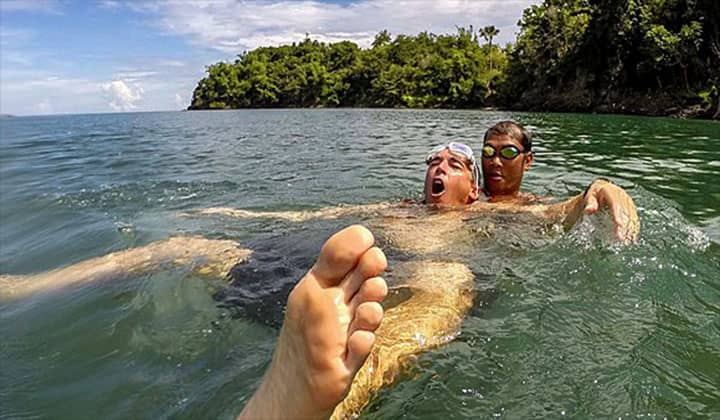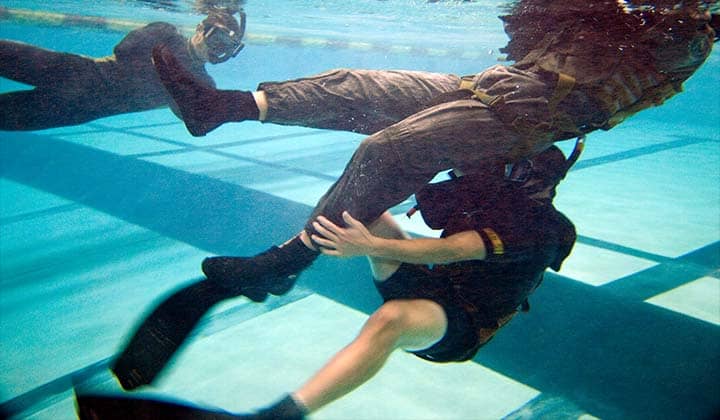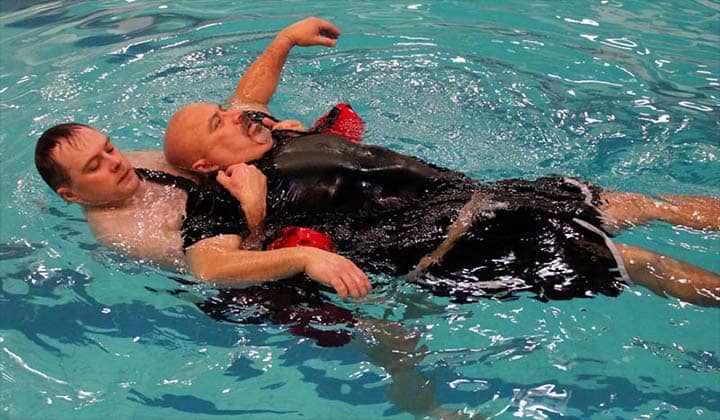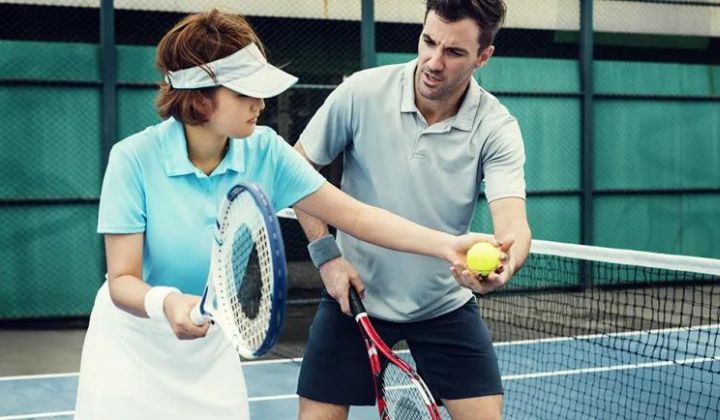Drowning rescue is a measure to save people who are drowning due to an incident on the water. Depending on the specific situation, decide to use the appropriate method. Usually there are two main methods:
Direct drowning
Nội dung tóm tắt bài viết
When there is no rescue equipment or the drowning person is in a comatose state, the following points should be paid attention to for direct drowning:
Before entering the water, it is necessary to observe the position and status of the person drowning (submerged, awake or comatose). If the drowning person is in calm water, the rescuer can directly enter the water and swim straight to the drowning person to save. In case a person is drowning in a fast-flowing area, the rescuer can run on the shore to catch up and swim out to rescue the drowning person.

If the rescuer does not know the terrain of the water area where someone is drowning, they should never jump headfirst into the water, but should spread their legs in front and back. Arms outstretched forward jump into the water or swim quickly from the shore.
When approaching, it is advisable to swim breaststroke to easily observe the status of the drowning person. If the drowning person is struggling, do not rush to approach directly, but cautiously approach from behind to avoid being hugged by the drowning person. When approaching from behind, lift and push them to the surface. Then use sidestroke or backstroke to help them get to shore and perform first aid.
The rescuer must know how to get out in unexpected situations.
Indirect rescue

Drowners take advantage of available tools to save drowning people while they are still awake. For example, toss buoys, boards or poles to respond promptly.
Liberation in the water
1. Method of release when being held hands
If the person drowning grasps both hands from below or above. The rescuer must make two fists to rotate inward or outward toward the drowning person’s thumb to free and support the drowning person. If the drowning person grasps one of the rescuer’s hands with both hands, the rescuer grips the fist of the caught hand. The other hand is placed between the hands of the drowning person, grasping the fist of the hand being pulled down to free and support the drowning person.

2. Solution to escape when being hugged from the front
If the drowning person holds his left hand (right hand). The rescuer uses his right hand (left) to push his right elbow (right). The hand (right) grasped the drowning person’s wrist and pulled it down, then suddenly passed through the drowning person’s arms. Use your hand to hold the drowning person’s wrist and rotate it to the bottom and back to help the drowning person.
3. The method of liberation when being hugged behind the back of the neck
First, hold the drowning person’s wrist tightly, bring the other hand down and push the elbow from the bottom up. Causing the drowning person to turn. Then lower your head always over your armpit and turn around to pull the drowning person’s wrist back and help the drowning person.
4. The method of liberation when being hugged across the back in the back
The drowning person grabs one finger in both hands of the drowning person with two fingers, stretching it to the sides. Then let go of the drowning person’s hand, turn around behind the drowning person and help the drowning person.
5. Methods of release when being hugged across the back in front
The drowning person holds one hand behind the head, one hand holds the chin tightly, turns the drowning person’s head out. Make the drowning person’s back turn around and support the drowning person.
6. The method of liberation when being hugged tightly with both hands and body from behind
The rescuer used his two feet to push down hard, causing both of them to float up high. When sticking your head out of the water, take a deep breath, and at the same time use your hands to bend out. Sudden sinking and escaping between the hands of the drowning person. Then turn the drowning person’s back to your face to help the drowning person.
How to help someone who is drowning

The rescuer uses the side or backstroke to help the drowning person to shore. Then quickly carry or carry the drowning person to the necessary emergency place. If there is only one person to rescue, place the drowning person on his/her stomach over his shoulder. One hand is always between the thighs, the other is between the body of the drowned and carried away. If there are more than one person, two people pass through their arms and hold onto the hand of the person who is drowning. A third person stands between the legs and holds the drowning person’s thighs and carries them away.
CPR
Take the drowning person to a place where there is no cold wind and fresh air. Take off all your clothes, dry your body, use your fingers to wrap a bandage or a towel to clean the phlegm from your mouth and nose. If your mouth is too tight, you have to pry it open. Use two thumbs to push from back to front at the same time two index and middle fingers push the lower chin to open the two teeth of the drowning person. Then proceed to flush.

There are two ways to splash water: The rescuer has one leg to support, the other to kneel so that the drowning person lies on his stomach on his knees, his head is slightly down, pat or press firmly on his back to let the water flow out. With the drowning person lying on his or her stomach, the rescuer separates his legs to either side of the drowning person’s body. Put both hands on the stomach of the drowning person and use force to lift the drowning person up to let the water out. Then place the drowning person on a mat or dry blanket to conduct CPR by some of the following methods:
- Put the drowning person lying on his back, legs slightly bent, arms stretched out in front of the head, under the back (hip level) lined with a towel to raise the abdomen, use a blanket to wrap half of the body to keep warm. Pull the tongue to make the tip of the tongue stick out of the mouth or use a wooden blade between the teeth to open the mouth wide. The drowning rescuer kneels next to the drowning person. With both hands holding the drowning person’s hands, he slowly brought them down to his chest. Then use pressure to press down according to the breath, then slowly bring back to the original position. Repeat this movement several times until the drowning person can breathe.
- Let the drowning person lie on his stomach with his arms stretched out in front of his head, face turned to one side, the rescuer kneels on both sides of the drowning person. Two hands on hips, two thumbs on either side of the spine and two little fingers on the last rib of the drowning person. The drowning person follows his or her breathing, giving artificial respiration to the drowning person. When exhaling, press firmly and slowly from both sides to the drowning person. As you inhale again, slowly release your arms. Repeat this movement several times until the drowning person can breathe.
- Place the drowning person on his or her back. The rescuer puts one hand behind the back of the drowning person’s neck and lifts it up, pulling the head back with the other. Lift the nape of the neck to lie down and push the chin forward so that the skin of the neck is tight. Rest your other hand on the drowning person’s forehead and at the same time use two thumbs and forefingers between the drowning person’s head. The rescuer takes a deep breath, then puts his lips to the drowning person’s mouth and blows hard to push air into the drowning person’s lungs. Repeat this movement several times until the drowning person can breathe.
If the above measures are not effective, quickly bring the victim to the hospital.






